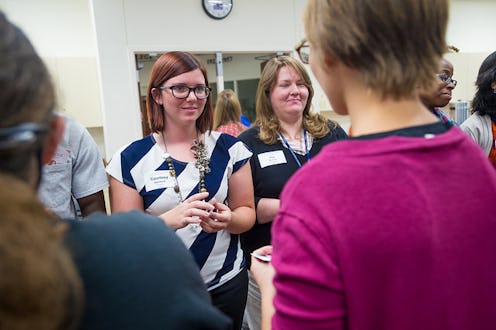Books
7 Etiquette Tips To Make Networking Less Scary

The one piece of advice I've received from every career counselor I've ever talked with is to "network." Although it can feel totally awkward to make small talk with strangers and promote yourself, it's a skill you will use throughout your career. The earlier you learn how to network, the easier it will get and the better you'll be able to do for yourself.
Learning the etiquette of networking, even after you've been at it for a few years, can be hard without an experienced guide. This is where Charles MacPherson enters the picture. MacPherson has worked for more than 25 years as a butler and household manager for some of the world's most opulent families, which makes him an expert in all things refined. His book, The Pocket Butler: A Compact Guide to Modern Manners, is a resource "geared towards young professionals" who want to learn these tricks of the trade and conduct themselves with poise in all social settings.
Modern-day etiquette, according to MacPherson, "gives us something to fall back on in new, strange or awkward situations," and these rules of behavior are exactly what you need when going into a networking event or business meeting. These seven tips from The Pocket Butler will provide the framework to make the whole networking experience much less painless and probably even pretty professionally productive:
Where You Put Your Name Tag Matters
Conventional wisdom states that you should put your name tag on the left side of your body, over your heart. But MacPherson contends, “It is highly important you always wear your name tag on the right side of your body. Why? Because when you shake hands, the right side of your body naturally moves forward. The name tag remains visible to the other person, and helps them see — and, more importantly, remember — your name.”
Make the Right Introduction
“Making introductions correctly is crucial," says MacPherson, but "this has nothing to do with old-fashioned manners and everything to do with making potentially uncomfortable situations simple and stress-free.” If you're introducing your peer to your boss, or your friend to your parent, “Introduce the person of lesser status to the person of higher status. Status may be based on rank, order of precedence or age.” Make eye contact, and maybe most importantly, be sure you correctly pronounce everyone’s name. “This might require a bit of research in advance, but it will unquestionably be worth it."
Know When to Shake Hands...
You should shake someone’s hand when you’re meeting coworkers for the first time, being introduced to new business contacts, or congratulating someone. Do not offer your hand first if the person you’re greeting is of a higher rank than you or if the other person has their hands full.
And Make Sure You Have a Balanced Handshake
At this point, we all pretty much know not to give a vice grip of a handshake. (MacPherson calls this a “bone crusher” handshake.) But you also don't want to have a weak, floppy hand. “Balance is the key to a good handshake,” as is maintaining eye contact, smiling warmly, and keeping “your palm open and connect ‘web to web’ (palm to palm).”
Have a Polite Conversation
A butler is a pro at making a good first impression, and MacPherson has several tips to impressing someone right off the bat. “When meeting someone for the first time, repeat his or her name in your conversation,” and always maintain eye contact and a confident posture. But don't come off as arrogant. “Check your ego at the door. Wait until you have established credibility before you even consider challenging someone you’ve just met.”
Politely Hand Off Your Business Card
Once you've charmed the pants off your new contact, it's time to swap business cards, and there's even a proper etiquette for that. “While business card etiquette is much more relaxed in Western cultures," explains MacPherson, "it is still important to be respectful in how you approach this exchange." MacPherson strongly suggests following, "The more formal Asian method of offering a business card with two hands," noting that, "when you use this method in the West, people are impressed. It makes you appear both worldly and knowledgable to use the formal style."
Send a Pro Follow-Up Email
After connecting with a new person, you should follow-up with an email. And, really, this advice is helpful for anyone who has to send emails at their workplace... which is all of us. “When communicating via email, keep it brief, on topic and specific.” If what you want to say is going to be too complicated to write out, give the person a call. Avoid texts with professional contacts, unless it’s along the lines of, “I’m running a little late to our meeting.” And even in this digital age, MacPherson reminds us to never forget the power of a good handwritten note.
So, DO IT. Go network your brains out. You're a pro now.
Images: tamuc/Flickr; roseluongo/Instagram; Giphy (3)